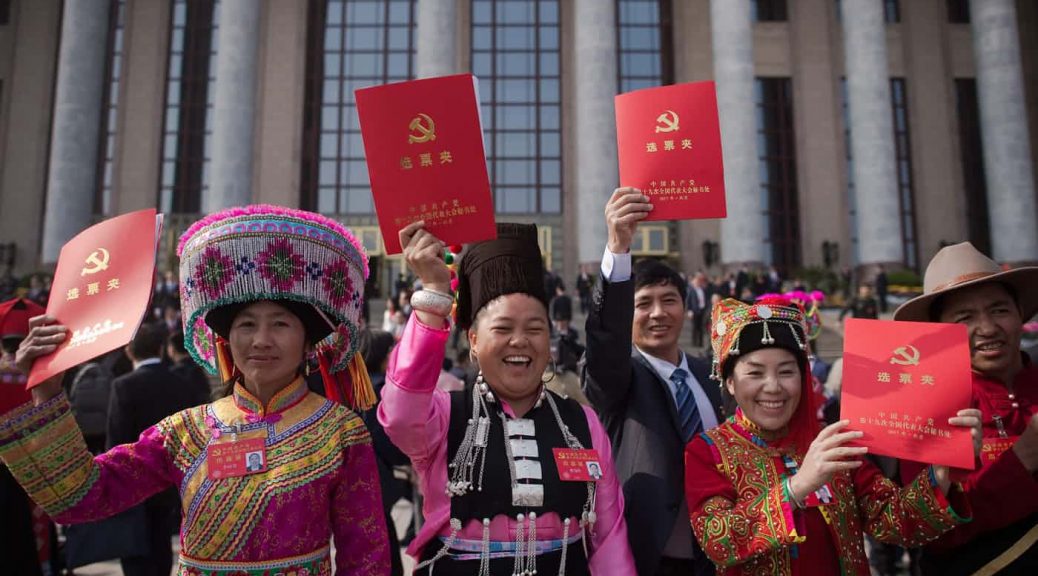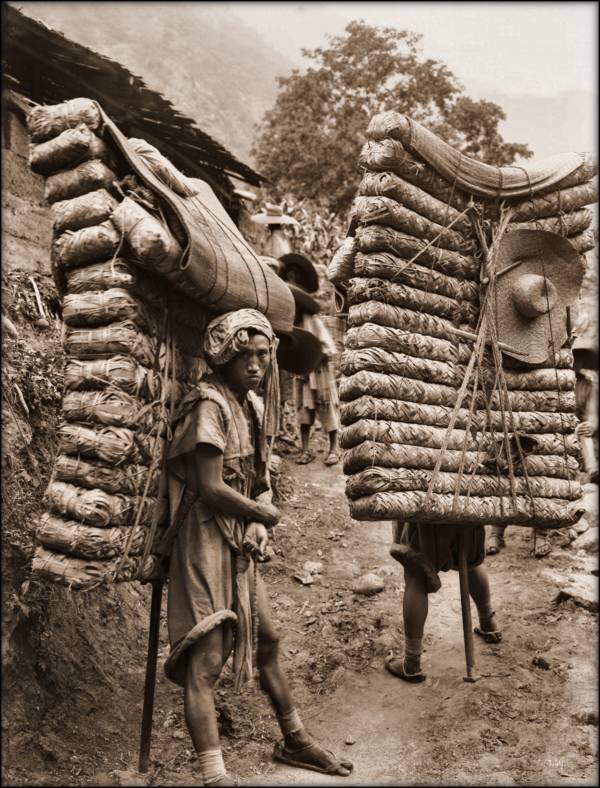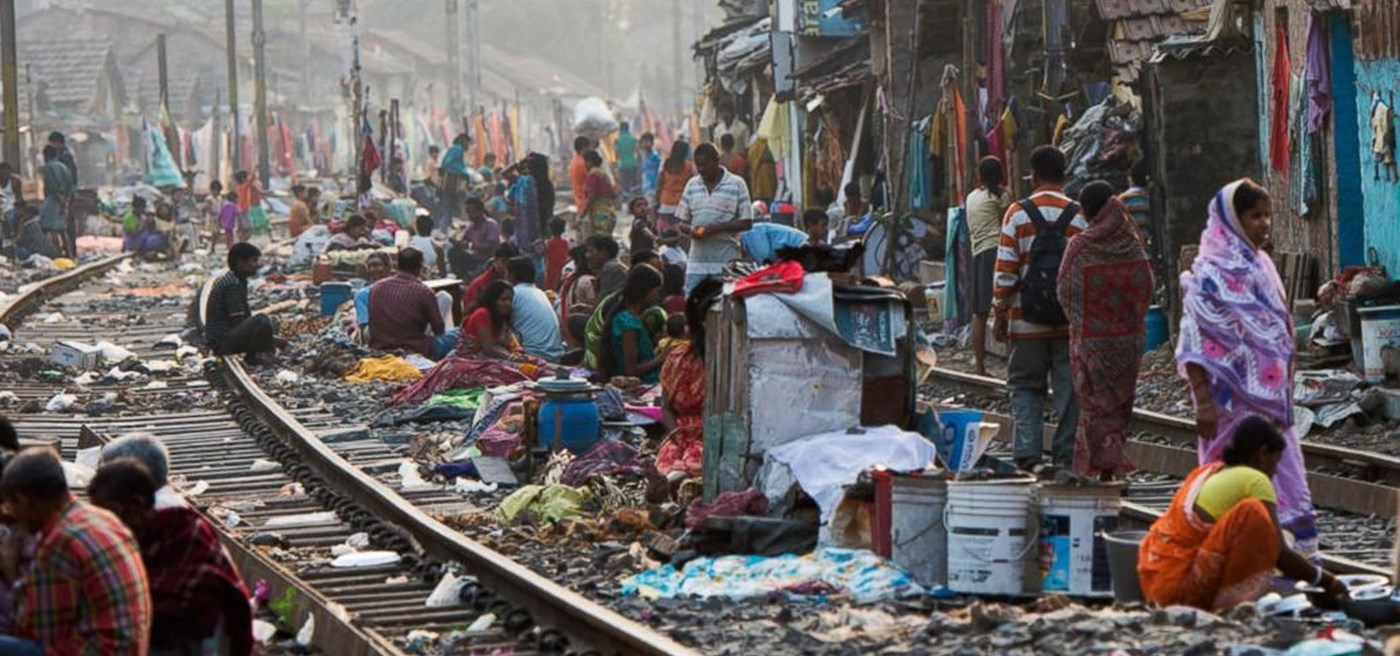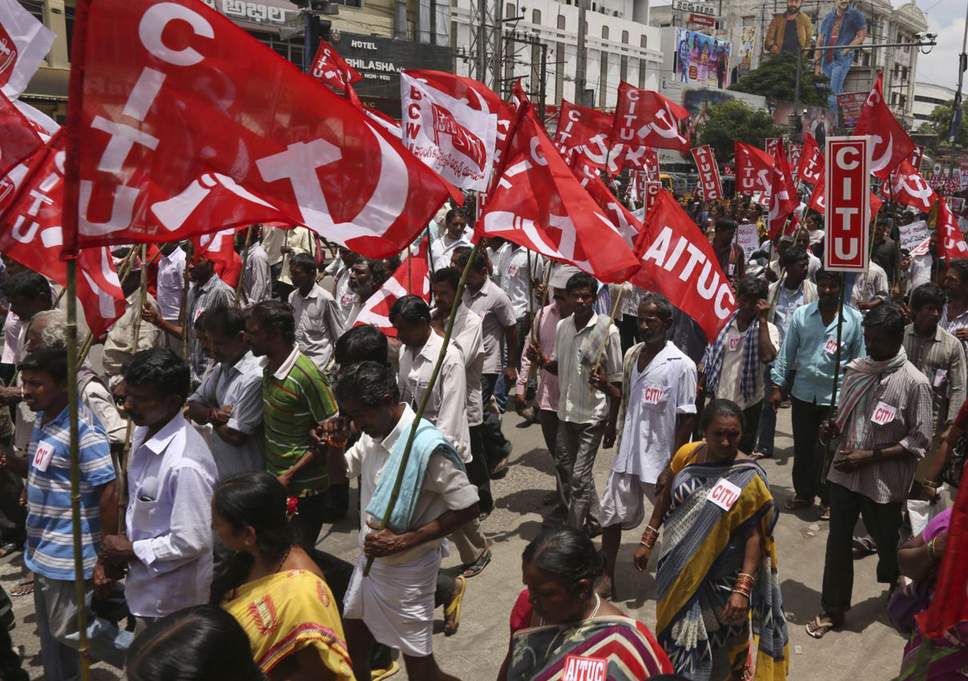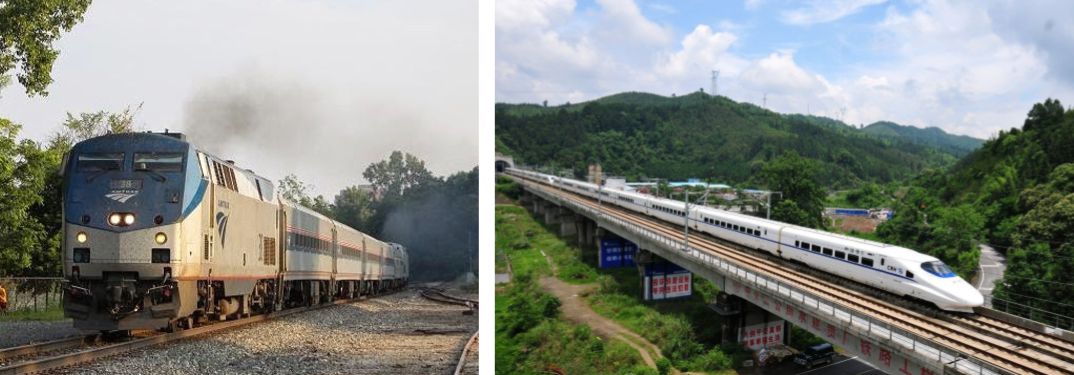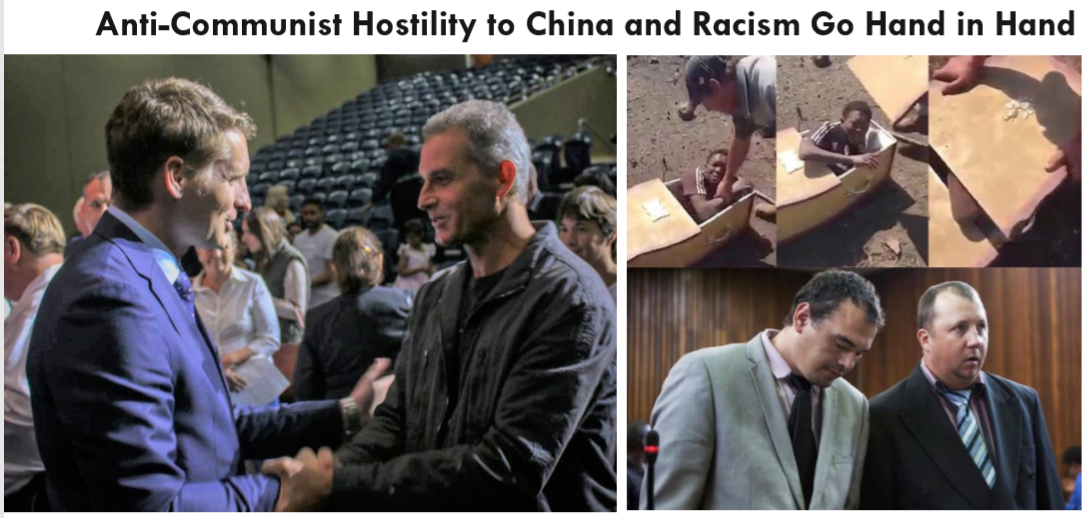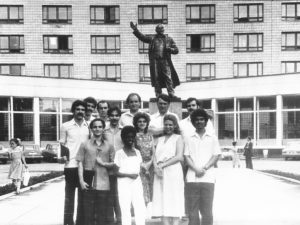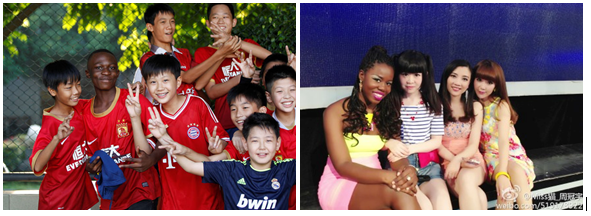Defend Socialistic Rule in China!
The Last Cold War Against the Soviet Union
and the New One Against Socialistic China
28 May 2020: What a last few months it has been in terms of Australia’s “relations” with its biggest trade partner, the Peoples Republic of China (PRC)! Firstly, even after the PRC had effectively squashed the coronavirus spread by late February, Canberra continued to maintain a discriminatory travel ban almost exclusively on PRC citizens, while for weeks allowing large numbers of infected people to enter from the U.S.A and Europe without any screening and quarantine. Then two months ago, the mainstream media, right wing politicians and members of his own Labor Party launched a hysterical witch-hunt against senior NSW upper house MP, Shaoquett Moselmane, for simply having the temerity to state what many infectious disease specialists had already explained: that China had taken effective measures that had fought and contained the coronavirus threat. All the while, the mainstream media could not let a week pass without “finding” – or rather manufacturing – a story on which to attack the PRC. It was just like in the days of the last Cold War against the then Soviet Union. Then last month, senior government politicians, like home affairs minister Peter Dutton, stepped up their campaign to despicably blame China for the virus outbreak. Associated with this propaganda campaign, the Australian regime spearheaded the push for a witch-hunting anti-PRC “inquiry” into the virus’ origins which the foreign minister said would involve “investigators” acting like weapons inspectors, thus evoking the notorious “weapons inspections” that were the prelude to the 2003 U.S./British/Australian invasion of Iraq.
It is pretty evident that we are now no longer merely facing the threat of a new Cold War. We are actually now in a new Cold War – a Cold War directed mainly against socialistic China and those living in the West with even the slightest sympathy for her. Thus, it is worth looking back at the last Cold War. That Cold War was also focussed against the most powerful socialistic country of the time, which was then the Soviet Union. It is a myth that the capitalist powers’ hostility to the Soviet Union only began around 1947. In fact, it actually started in late 1917 from the very moment that the working class and other toilers of Russia overthrew their exploiters and took state power into their own hands. Soon after this October 1917 Socialist Revolution, over a dozen foreign states including Britain, Australia, Japan, the U.S. and France sent troops to assist Russian counter-revolutionaries seeking to restore capitalist rule there through bloody civil war. The capitalist powers understood that the 1917 triumph of the working class in Russia would inspire revolutionary struggles of workers around the world. So they resolved to crush socialism before it could establish itself and spread. However, after the invading capitalist armies and their Russian counter-revolutionary allies were defeated in the Civil War, the capitalist powers became partially engrossed in their own inter-imperialist rivalries. Later they were also focussed on trying to crawl out of the 1930s Great Depression that had wreaked havoc across the capitalist world. All the imperialists still wanted to crush the Soviet workers state. However, with the Soviet Union then much weaker, the British and French capitalists were equally concerned about the resurgence of their German imperialist rival. But the outcome of World War II and its aftermath changed all that. The strength of the Soviet Union and of pro-communist movements became greatly enhanced. The heroic victory of the Soviet Red Army and her communist partisan allies over the Nazis had led to the foundation of new socialistic states allied to the Soviet Union in Poland, Hungary, East Germany and other parts of Eastern Europe. Furthermore, local communist partisans with the assistance of the Soviet Army had overturned capitalist rule in North Korea and Yugoslavia. Moreover, although 75 years later, Western propaganda has managed to obscure this truth from many people, everyone at the time knew that it was the Red Army and her allies who had largely defeated fascist Germany. The overwhelming majority of the fighting against the Nazis was in the Eastern Front where the Red Army and her allies stood up to the Nazis and their allies. Of all the casualties in the European and North African theatres of the war, more than 90% were in the Eastern Front. The U.S., Britain and their allies did not make a serious attempt to defeat the Nazis until they saw the Soviets winning in the Eastern Front. Although they partly sold their war as a “war against fascism”, the Allies’ opposition to Hitler, in as much as it existed, was driven by imperialist competition. And their main reason for finally opening up a second front against Hitler was to get to Germany before the Soviet Union did. Many people at the time could see through all this. They were only too aware of how the bulk of the French capitalist class and that of many other Western capitalist classes had collaborated with the German and Italian fascists. As a result, many of the capitalist classes in Europe and around the world were discredited, tainted with fascism and threatened with working class revolts at home. In contrast, the Soviet Union’s predominant role in crushing the hated Nazis greatly increased her authority. Around the world, Communist parties grew in numbers and anti-colonial movements influenced by Marxist ideas emerged. Alarmed by all this, the capitalist regimes moderated their rivalries in order to unite against their common threats: communist movements, the Soviet Union and the other socialistic states. In 1947, the U.S. imperialists backed up by the weakened West European and Japanese capitalist rulers and capitalist regimes in Australia and elsewhere unleashed a Cold War to contain and crush communism and the socialistic states.
The Cold War became more intense in 1949 after the toiling masses of China led by Mao Ze Dong’s Communist Party of China (CPC) overthrew the landlords, imperialist-puppets and capitalists of China and set about on a socialistic path. Then after socialistic North Korea and her Red Chinese allies humiliated the U.S., Australian and other imperialists by holding them to a stalemate in the 1950-53 Korean War, Cold War fears reached fever pitch. In many countries a McCarthyist anti-communist witch-hunt – named after U.S. senator Joseph McCarthy who played a key role in inciting it – was unleashed. In the U.S. in the late 1940-1950s, thousands upon thousands of teachers, wharfies, seamen, university academics and government employees were driven out of their jobs on the basis of the slightest alleged sign of communist association or lack of adequate hostility to the Soviet Union. Large number of Hollywood actors, writers and directors were also forced out of their jobs and blacklisted. Hundreds of communists and alleged communists were jailed. Meanwhile, in Australia, several Communist Party of Australia (CPA) leaders were imprisoned alongside communist trade unionists. The government even raided CPA offices in the midst of a witch-hunting atmosphere that almost saw the CPA banned in 1951.
Internationally, in the 1950s and 60s, the main target of the Cold War was the Soviet Union followed by the other socialistic countries: China, North Korea, North Vietnam, Cuba and the East European countries. However, in the early 1970s, PRC leader Mao betrayed the socialist cause and his own laudable role in leading China’s 1949 anti-capitalist revolution by entering into an alliance with U.S. and Western imperialism against the Soviet Union. Treacherously enlisting in the Cold War against the Soviet Union was the price that the national-centred CPC leadership paid for dubious “guarantees” of peace and reduced hostility from the capitalist powers. However, after capitalist counterrevolution drowned the Soviet and East European workers states in the 1989-1992 period, the PRC itself became the main target of imperialist hostility.
Why Capitalist Hostility to Red China Has
Grown So Much Over the Last Three Decades
In the early 1990s, the level of imperialist opposition to the PRC was somewhat muted in comparison to today. At that time, it had only been just over 40 years since the Chinese Revolution. Thus, China then still had a very long way to catch up from the horrific poverty and backwardness of its pre-1949 days when it was a brutally subjugated neo-colony of the imperial powers. The capitalist powers did not see the Red China of the early 1990s, now without the presence of the Soviet Union, as much of a serious force to be reckoned with as they do, indeed, today. Moreover, drunk with triumphalism following their defeat of the Soviet Union and encouraged by the right-wing market reforms in China renewed by then PRC leader Deng Xiaoping in 1992, many capitalist strategists expected that it was only a matter of time before the emergence of a sizable private sector in China would open the way to capitalist counterrevolution there the way that Gorbachev’s perestroika had opened the road to the same in the Soviet Union. However, nearly three decades on, imperialist perspectives about China have changed considerably.
There was no one single event, equivalent to the outcome of World War II in terms of the previous Cold War against the Soviet Union, that hardened the attitude of the capitalist powers against the PRC. Rather there has been a series of events and processes. One was the way that the PRC sailed through the 1997 Asian financial crisis. That economic implosion seriously buffeted the capitalist economies in East and Southeast Asia, including the so-called “tiger” economies. By contrast, the PRC dealt with the crisis with ease. This alarmed Western ruling class analysts. Meanwhile, they grew steadily concerned at the rapid rate of economic development in the PRC, which was – and is – still based on a dominant socialistic public sector. In the late 1990s – early 2000s, China’s GDP was growing at around 10% per year. This was much faster than that of any of the capitalist countries. Then Beijing’s successful – and indeed spectacular – hosting of the 2008 Olympic Games heralded socialistic China’s emergence as a world power. Soon after, the then worst economic crisis since the Great Depression hit the world. The late noughties Great Recession caused massive job losses and economic contraction in the capitalist world. Many countries, especially in Europe, not only took a very long time to recover but in some sense have never fully recovered from this economic shock. In contrast, the PRC stormed through the crisis by bringing the advantages of her socialistic system to bear. Her GDP growth rate never even dropped below 6% per year.
There was another development that equally worried capitalist ruling classes. Far from their predictions that market reforms would gradually see China move towards capitalist restoration, by the mid-2000s China started to move in the opposite direction. Pushed by mass working class protests and struggles and demands by people on the left-wing of the CPC, the PRC’s leaders’ curbed privatisations and helped fortify her socialistic state-owned enterprises (SOEs). Far from becoming obsolete, these SOEs were becoming increasingly successful and powerful. Moreover, the period from about 2005-2012 saw a wave of crackdowns on capitalist tycoons within China and nationalisations and re-nationalisations of privately owned companies. Indeed, the period from 2008 to 2011, in particular, was in many ways China’s most left-wing period in four decades. So when Xi first took office in 2012, pro-capitalist strategists and academics hoped that he would renew rightist reforms. However, some three to four years later those hopes became dashed too.
Meanwhile, the rise of Red China was having an effect on the world that infuriated the imperialists. These imperialists have always plundered the so-called “Third World.” When “engaging” with these semi-colonial and neo-colonial countries, the imperialists demand as a condition for granting access to capital, technology and markets, their “right” to exploit labour, plunder natural resources, set a low price for purchased produce and leach huge profits through debt service payments. However, over the last decade and a half, China started engaging in large-scale, mutually beneficial and respectful cooperation with these ex-colonial countries. Her socialistic SOEs would hand over capital and technology to these countries as well as access to the huge Chinese market without robbing these countries blind or demanding that they privatise their public sectors or introduce grinding austerity. The Australian imperialists, in particular, were enraged at this as governments in the South Pacific, buttressed by these new found relations with the world’s only non-imperialist power, now felt more confident to sometimes resist Australian imperialist bullying. Famously, Fijian prime minister, Frank Bainimarama pushed back against the arrogant bullying of Australian prime minister, Scott Morrison, at the August 2019 Pacific Islands Forum. Asked if Morrison’s approach might cause some Pacific leaders to look to China, Bainimarama responded [1]:
“After what we went through with Morrison, nothing can be worse than him.
“China never insults the Pacific. You say it as if there’s a competition between Australia and China. There’s no competition, except to say the Chinese don’t insult us. They don’t go down and tell the world that we’ve given this much money to the Pacific islands. They don’t do that. They’re good people, definitely better than Morrison, I can tell you that.
“The prime minister was very insulting, very condescending, not good for the relationship.”
That is why despite making huge profits from exports to China, which is by far Australia’s largest export market, the Australian imperialists are bristling at how Red China’s “interference” in Australia’s “neighbourhood” is interfering with what they see as their “right” to trample over, patronise and squeeze every last bit of natural wealth out of the former colonies of the South Pacific and beyond.
Yet the emerging outcome of the COVID-19 crisis is likely to turn out to be by far the biggest single factor that leads to the ratcheting up of imperialist hostility to the PRC. In particular, there is the fact that while the capitalist countries have met the pandemic with at best a flawed, and more often a disastrous, response, socialistic China has implemented a strikingly effective response. The rulers of the capitalist powers are furious that the pandemic is ending up doing more damage to their own economies than it is to the PRC. Moreover, they are fearful that their own populations have seen China’s more successful response and are worried that they will draw pro-socialist conclusions from this.
Despite the obvious similarities between the last Cold War and this one there are also some notable differences. Pre-1949 China had been kept so backward – her per capita GDP was barely more than half of India’s at the time – that even after seven decades of catching up, China’s per capita economic strength is still weaker relative to that of the imperialist powers than the 1970s-1980s Soviet economy was relative to these same powers. Moreover, while the Soviet Union had basically achieved military parity with the strongest capitalist power, the U.S., by the end of the last Cold War, the PRC’s military remains much weaker than that of the U.S. Thus, while today the U.S. has well over 6,000 nuclear weapons, China has under 300 such warheads [2]. More crucially, communist and left-wing movements are much weaker today in the capitalist world than they were during the last Cold War. All this makes socialistic rule in the PRC all the more precarious; and by extension that makes the position of the working class in the capitalist world more vulnerable, because for all the bureaucratic deformations and excessive concessions to capitalism within China, the PRC remains a workers state whose success will mean great advancement for the masses of China and inspiration for the toilers of the world but whose demise would be a catastrophe for the working people of both China and the rest of the world.
On the other hand, one factor that makes the socialist and working class side in this Cold War stronger than the last one is China’s sheer population size. Today, the world’s biggest socialistic country encompasses one in five of the world’s people. Secondly, the capitalist economies are far more fragile than they were during the last Cold War. Moreover, the late noughties Global Recession has left a lasting crisis of self-confidence amongst the capitalist ruling classes around the world – something that has only been amplified by their failed and callous response to the COVID-19 pandemic. This is what has made them so panicked about Red China’s rise and made them so hysterical about Chinese “interference” undermining their ability to “freely” rape the peoples of the South Pacific, Africa, the Middle East, South America and key chunks of Asia. As a result, the imperialist powers have become ever more provocative in their efforts to exert military pressure on China – such as through ever more aggressive U.S., British and Australian incursions through contested waters in the South China Sea and bigger arms sales to Taiwan – more brazen in their backing of anti-communist forces within China and ever shriller in their witch-hunting of anyone at home “guilty” of being soft on Red China.
Ironically, there is one aspect of Cold War fears of socialistic powers that actually brings some benefits to the working class masses in the capitalist world. During the last Cold War, in order to make the Soviet Union less attractive to their own masses relative to their own capitalist system, the capitalist rulers in the West conceded certain welfare state provisions and rights to their own workers in excess of what they actually wanted to. Once they managed to destroy the Soviet Union they, of course, began rolling back these concessions. However, today as they grow more concerned about the potentially attractive power of a giant rising socialistic power, they are posed with the need to make new concessions to their own working people. This was seen most clearly with the response of some capitalist countries to the COVID-19 pandemic. The impulse of most of the capitalist powers was to avoid excessive economic shutdowns and social distancing measures that could hurt corporate profits. Their initial inclination was to adopt a “herd immunity” strategy of basically letting most people get infected – on the grounds that the society would then get immunised – so that economic damage could be minimised. This “herd immunity” strategy was in effect a callous program to cull the herd of millions of old, ill and poor people, the people most likely to die if infected. However, with socialistic China having already responded to the pandemic with measures that put her peoples’ lives above that of her economy, some capitalist rulers felt compelled to partially retreat from the “herd immunity” strategy in order to not seem so heartless and ineffective relative to Red China. This only infuriated the Western capitalist rulers even more as they feel that the PRC has, in effect, “cornered” them into taking measures harmful to their own beloved stock markets.
Socialists in the Capitalist World Must
Mobilise against Cold War Attacks on the PRC
If some of the capitalist regimes have felt the need to not appear so inhumane in comparison with the PRC’s people’s first approach to COVID-19 by reluctantly replicating, in part, some of her economic shutdown measures, we had better consider what would have happened if there had been no socialistic giant on the planet like the PRC. What if the capitalist powers knew that people would not have any sizable non-capitalist country to compare these rulers’ response to COVID-19 with? If they could administer a “herd immunity” “strategy” and then tell people that this is all that can be done and that is what everyone is doing anyway? What if most governments thought that they could get away with replicating the worst of Trump’s so-called responses to the pandemic, with unleashing the callous “herd immunity” “strategy” that Britain’s Boris Johnson implemented at the start and which social democratic-administered Sweden and the fascistic Brazilian regime of Jair Bolsonaro alike are catastrophically still set on today? As disastrous as the response of most capitalist countries has been today, how many tens of millions of people would already be dead if that scenario played out? And consider how events would have played out in China itself had socialistic rule already been overturned there. Would China even have been the first country to detect the virus? Would the health system have been so devastated in China, as it has been in Russia since the 1991-92 capitalist counterrevolution, that tens of thousands of people would have died in Wuhan before anyone even noticed? Would a capitalist China have replicated the disastrous “response” of capitalist Brazil which is, after all, a country with a similar per capita GDP to China? How many millions of people would then have died in China from the virus?
If one ponders these questions then it becomes crystal clear just how much is at stake in the outcome of this new Cold War. And most importantly it shows just how crucial it is that those concerned with the interests of the working class masses and the fate of humanity stand by socialistic rule in China today. That means that we must oppose all the military pressure that the imperialists are unleashing against the PRC. We must demand that the U.S. and Australian navies stop their provocative naval runs through the South China Sea, that the U.S. troops stationed in Darwin, which are aimed against the PRC and her socialistic North Korean neighbour, get out and that the joint U.S.-Australia spy bases at Pine Gap and Geraldton are closed. The Left and workers movement must also oppose the massive political, financial and media support that the U.S., British and Australian governments are giving to forces within China seeking to undermine socialistic rule there – whether they be the violent pro-colonial, rich people’s opposition in Hong Kong, pro-capitalist “dissidents” on the mainland or the rabidly right-wing, anti-secular forces based on a minority of the Uygur community in China’s north-west. We need to energetically resist the propaganda war against the PRC.
We should understand that just as the 1991-92 capitalist counterrevolution in Russia strengthened capitalist exploiting classes everywhere, the defeat of socialistic rule in China would embolden the capitalist rulers in this country and around the world to further attack workers’ rights, push through still more privatisations and further slash public housing and other services most needed by working class people. However, if the Left is not to lose this new Cold War like we lost the last one we must learn the bitter lessons of that previous defeat. Socialistic rule in the former Soviet Union and Eastern Europe was crushed by the combined weight of imperialist military, economic and political pressure. Serious defects in the structure of those workers states – including the lack of workers democracy and the existence of material privileges for the administering bureaucracy both of which depoliticised the masses and undermined their commitment to defend socialism – made these workers states more vulnerable to the immense capitalist pressure bearing down upon them. However, from the point of view of leftists living in the capitalist world, the most important lesson from the last Cold War to grasp is that a key reason why socialistic rule in Russia and Eastern Europe was destroyed is because the workers movement in the West failed to come to the defence of these workers states. Indeed, the mass social democratic parties within the capitalist world – including the ALP in Australia – actually supported the anti-communist Cold War drive against the Soviet Union. Treacherously, so did much of the Far Left. In Australia, the group inspired by the theories of late British leftist Tony Cliff, the International Socialist Organisation (ISO) – the parent group of today’s Cliffite groups Solidarity and Socialist Alternative – enthusiastically supported every major anti-communist movement that worked to destroy the Soviet Union. Their excuse for taking this stance was to ridiculously claim that the Soviet Union was merely just another form of capitalist state – even as the real capitalists did everything in their power to crush the Soviet Union precisely because it was not capitalist! Unlike the Cliffite ISO, the Democratic Socialist Party, the forerunner of today’s Socialist Alliance, accepted that the Soviet Union and her East European allies were workers states of some form. Yet, bending to Cold War pressures, they too supported the key imperialist-backed counter-revolutionary movements that destroyed these workers states. Thus, they joined the ISO in hailing Poland’s anti-communist Solidarnosc movement and then supporting arch-counterrevolutionary Boris Yeltsin’s August 1991 counter-coup, the decisive event in the defeat of the Soviet Union.
There were some in the left in Australia, like the old SPA (Socialist Party of Australia) – the fore-runner of today’s Communist Party of Australia (the SPA changed its name to the Communist Party of Australia in 1996) – that did at least have enough political courage and understanding to stand by the Soviet Union. However, intimidated by the intense anti-Soviet “public opinion” at the time, they did not promote their pro-Soviet politics too aggressively within left milieus. Most notably, they largely refrained from building actual actions on the streets in defence of the Soviet Union. Instead, the pro-Soviet component of Australia’s Left tried to make common cause with left-liberal peaceniks who, while opposed to the war-mongering of their own rulers, were at best neutral on the Cold War and were opposed to any overt displays of sympathy for the Soviet Union. Thus shackled by this alliance – or at least this quest for an alliance – with pacifist members of the upper middle class, middle class and even tiny clots of the capitalist class, the pro-Soviet elements were unable to connect the need to defend the Soviet Union with the class struggle interests of the Australian working class and were reluctant to mobilise any defiant street actions in solidarity with the Soviet Union. A similar dynamic took place within most of the imperialist countries. And so the Soviet masses looking abroad at the capitalist powers saw only hostility – from governments, the mass social democratic parties and much of the Far Left – or at best neutrality (from the left-liberal pacifists and class-collaborationist pro-Soviet elements following in their tails). This, on the one hand demoralised the pro-socialist workers within the Soviet Union and, on the other, emboldened those seeking capitalist counterrevolution. We cannot let the same thing happen to the Peoples Republic of China! It is the duty of those within the Australian Left who understand the need to defend the PRC workers state to build actions here in solidarity with socialistic rule in China. We must show staunchly pro-communist elements within China, seeking to defend socialistic rule there, that they are not alone, that they have support even within the imperialist centres.
We in Trotskyist Platform (TP) are proud to be the left group in Australia that is most actively building actions on the streets in solidarity with the PRC workers state. Unfortunately, the proportion of the Far Left in Australia that has any sympathy for the PRC is even less than the proportion that was pro-Soviet during the last Cold War. The Cliffites – this time in the form of Solidarity and Socialist Alternative – are at it again in effectively lining up on the side of imperialism in the Cold War. Just look at what they say about Covid-19 whenever they mention China! Although they have criticised some of the more bonkers anti-China conspiracy theories of the Far Right, they are repeating most of the talking points attacking the PRC pushed by the mainstream capitalists and their media. They claim that China tried to cover up the outbreak, had a “botched response,” failed to act decisively in the early days of the outbreak and even when they are forced to acknowledge China’s success in curbing the pandemic put it down to “brutal lockdowns” and “authoritarianism.” Why bother looking at a nominally socialist website to find such rubbish when you can read it all the time in the Murdoch and Fairfax (now owned by Peter Costello-headed Nine Entertainment) papers, hear it on 2GB or watch it incessantly on Channel Nine or the ABC? Somewhat differently, Socialist Alliance has simply avoided commenting on the attacks on the PRC over Covid-19. One could say that this is not as harmful as the actions of the Cliffite-based groups. However, putting one’s head in the sand when one’s “own” ruling class and its U.S. superpower ally is waging an intense campaign against the world’s biggest socialistic state is hardly what socialists should be doing. Moreover, like Solidarity and Socialist Alternative, Socialist Alliance continue to fervently back the Washington-backed, anti-communist opposition in Hong Kong.
Other than for TP, the only other active, bona-fide left group in Australia to defend the PRC is the Communist Party of Australia (CPA). We must note with encouragement that in the last period, the CPA – and, in particular, the Editorial section of its newspaper The Guardian – has taken a stronger position in defence of the PRC than their more perfunctory stance previously. In part this may be because a section of their party, including their former general secretary, who had anti-PRC views left the CPA a year ago. Those who left founded a new party called the Australian Communist Party which seems to have near identical positions as the CPA except on one gigantic issue: on the issue of China the new group shares the same pro-imperialist hostility to the PRC as do the Cliffite groups. For the CPA, it seems that with some anti-PRC elements having left their ranks and leadership and faced with the unmistakable need to take a stand in the face of an escalating new Cold War, they are strengthening their pro-PRC stance. Nevertheless, the CPA has still not adequately turned their pro-PRC written position into action on the streets. They would still rather talk about the more popular socialistic state in far-away Cuba and the more amenable to the social democratic-left, leftist government in Venezuela than about the need to defend the workers states most intensely targeted by Australian imperialism: the PRC and the DPRK. From the outside it seems that on the positive side there is the CPA’s Brisbane Branch and chunks of their Sydney membership who strongly want to defend the PRC. On the other hand, it seems that there are still individuals within the CPA who hold at best a neutral attitude to the PRC and others who believe that the issue should be downplayed so as not to interfere with a quest to build a “people’s front” alliance with the Greens and other anti-PRC progressive-liberals. To this we would say that the defence of socialistic rule in the world’s most populous country – especially when Cold War hostility to that state so dominates this country’s political life – cannot be made an optional extra for anyone calling themselves a Marxist-Leninist or a communist. This is not a question one can simply “agree to disagree on” while amicably existing in the same party. It should be absolutely mandatory for communists to actively stand in defence of the PRC and the other remaining workers states against imperialist attacks and internal counterrevolutionaries.
We look forward to in the future joining with the CPA and the many pro-PRC leftists who are not part of any political group in united front actions in solidarity with the PRC and in opposition to military, political and propaganda attacks on her. By pointing to the policies facilitated by the existence of a workers state in China that would be attractive to working class activists in Australia – like the widespread availability of public housing, the crackdown on housing speculation, the nationalisation of China’s banks, the dominance of public ownership over China’s finance sector, ports, airlines, car plants, infrastructure construction, steel industry, mining, energy, shipping etc, the jailing of bosses for deadly workplace accidents and the frequent crackdowns on greedy capitalists – we can connect the need to defend the socialistic PRC with the class struggle against capitalism here. One thing that we must realise is that because the interactions between Australia and China are far greater than those that existed between Australia and the Soviet Union – i.e. there is far more travel and tourism between China and Australia, there are far more international students from both China and Australia studying in the other country, far more people from each country working in the other country and, additionally, there are a large number of PRC immigrants living in Australia – what happens here with respect to China will have much political influence on events within China. The stakes are thus higher in terms of the stance that leftists take in Australia with respect to the new Cold War. On the negative side, word about any demonstrations supporting the anti-PRC, pro-colonial rioters in Hong Kong, in which the likes of Solidarity, Socialist Alternative and Socialist Alliance have been participating, will get back to China. On the positive side, word about any mobilisations supporting the socialistic PRC will also quickly get back to the Chinese masses. An example of the latter was seen on the Labour Day public holiday in NSW last October, when in an action built largely by the Australian Chinese Workers Association and Trotskyist Platform, around 60 socialists from a range of political backgrounds marched through the streets of Sydney behind a banner saying, “WORKING CLASS PEOPLE IN AUSTRALIA & THE WORLD: STAND WITH SOCIALISTIC CHINA!” and “DEFEAT HONG KONG’S PRO-COLONIAL, ANTI-COMMUNIST MOVEMENT!”
For socialists, a Cold War political climate can be intimidating and isolating. But we must stand strong! And we must never forget that the same Australian capitalist ruling class that has managed to, at this stage, deceive a considerable section of the working class masses into backing their Cold War drive are the very ones who now threaten these same workers with new cuts to their pay and conditions under the cover of “rebuilding the economy,” who increasingly drive working class youth into insecure casual jobs, who throw out of work at will the very same workers who made them their fortunes whenever they can’t make enough of a profit out of these workers and who have allowed rental accommodation to become cruelly expensive for most working class people. After all, it is precisely because they know that their own masses have such grievances that the Australian ruling class is so fearful of the existence of a socialistic giant in its Asian neighbourhood.
In responding to the new Cold War we should never be put off by the fact that socialistic rule is currently flawed in China. The Chinese workers state is bureaucratically deformed and more seriously, the CPC leadership have allowed the emergence of way too much of a private sector. Dangerously, the CPC tops have allowed some of the new capitalists to gain too much influence. Thus, just like in the case of the former Soviet Union, socialistic rule in the PRC is fragile and her transition to complete socialism is far from assured. Yet that only makes it more crucial that we stand in defence of the PRC workers state. As we wrote in Issue 8 of our journal 13 years ago:
“The fact that the Chinese proletarian [i.e. workers] state is bureaucratically deformed actually makes that state more in need of global workers support and not less. When a structure is distorted it is able to carry less load. So too, the points of deformations of the PRC can cause that workers state to collapse when the heavy weight of imperialism is bearing down on it. But if the action of the international labour movement relieves that load, it gives a chance for workers to repair the deformed structure. When that happens, the Chinese working people will build a glowing, ‘peoples oriented’ society. A society that will be a huge landmark that will help map out all of humanity’s march towards socialism. When that global march becomes unstoppable and when the Chinese toilers are able to complete the work that they began in 1949, by finally chiselling out and throwing away the last remnants of exploitation of man by man, then we can truly speak of a harmonious socialist society. We will then be able to speak of ‘social harmony’ because the class struggle would have been completed to the extent that there are no longer any classes. And from such a harmonious socialist society, humanity, in all its beautiful diversity, can dance merrily towards a glorious communist future. However, for this not to be a mere dream, militant unionists and leftists in the West must act now. Act now to counteract the imperialist pressure bearing down upon the Chinese workers state. A state, that however divergent from the ‘ideal,’ is still today saving 20% of the world’s population from the tender mercies of capitalist rule.”
References
- Kate Lyons, Fiji PM accuses Scott Morrison of ‘insulting’ and alienating Pacific leaders, The Guardian website, 17 August 2019, https://www.theguardian.com/world/2019/aug/16/fiji-pm-frank-bainimarama-insulting-scott-morrison-rift-pacific-countries
- Arms Control Association, Nuclear Weapons: Who Has What at a Glance, Arms Control Association website, July 2019, https://www.armscontrol.org/factsheets/Nuclearweaponswhohaswhat (accessed 9 May 2020)










